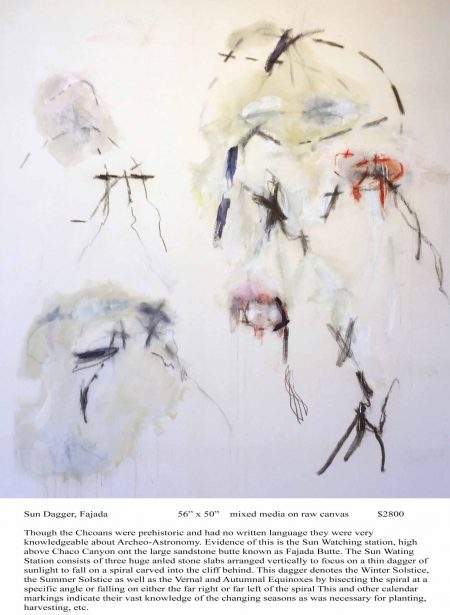Anne Bjork, an artist whose work I was unfamiliar with until visiting the gallery; is originally from New Mexico and now resides in and is a part of the adjunct faculty in University of Kentucky’s Fine Art Department. Bjork’s work intends to ‘capture the essence of mystical ruins of the ancient Anasazi pueblos in her native New Mexico’. Anne uses large square canvases, about 60” x 60”, to make ‘dynamic statements about the ‘monumental sandstone walls, ceremonial kivas, buttes and canyons which appear as angular lines of different weights, thicknesses’, and stains.
Upon walking into B. Deemer’s main exhibition gallery, the viewer is greeted by six large, mainly off white canvas panels. Each painting is paired with a title card that also contains a 3 or 4 sentence narrative semi-declaring the subject of the painting— I’ll return to these cards later. All six raw canvas panels were painted onto with acrylic paint and charcoal. Bjork uses line and manic scribbling gestures in conversation with staining of the canvas to depict non objective representations of canyon walls and ancient extinct volcanoes. Although Bjork is almost exclusively working with line and a variety of opposing mark making, it is clear that she is depicting atmospheric or spacial content. Her palette is minimal, utilizing charcoal, black, red, and occasionally a soft navy acrylic paint within her application. For me, the most impressive was her usage of oil or non pigmented medium to stain the canvas in substitution of a color or blending of material, for such minimal effort, it had the greatest impact in terms of creating the illusion of space and the action had a very ghostly effect on the work that was subtle and appealing.
As background information, B. Deemer Gallery is a commercial space located within Louisville’s Crescent Hill neighborhood. B. Deemer has been running since 1990 and represents over 50 living artists, all working within traditional two-dimensional media, and most living in the Ohio Valley. B. Deemer also runs a framing facility that is open to the public and visible from the exhibition gallery and the representation gallery and office. The front exhibition space is of fair size and has a large front window that opens to Frankfort Avenue, a scenic street that is simultaneously bustling and homey.
Overall, the paintings felt ancient in narrative and depiction, but modern in form and execution. Her visual narrative seems to utilize mechanisms, motions, and a visual vernacular that is as relevant to William De Kooning as it is Hong Ren. In her artist statement, Bjork states that she uses marks resembling the ancient Anasazi Indian culture’s iconic symbols. I couldn’t see any obvious relation between Anasazi petroglyphs and the marks that Bjork employed, but they did have a similar energy— that ancient energy that I referred to earlier. The first thing that these paintings recalled, for me, were Chinese landscapes circa the Qing era of the 17th century. It wasn’t until reading the cards footed next to the paintings that I was aware of any Anasazi reference. Which brings me back to the cards: Each card had the title, date, price and a description. The title of the painting and the description topic were self referential, leading the viewer to believe that the painting is an abstract depiction of the aforementioned topic. Here lies my only complaint about the exhibition— the placing of these narratives next to the paintings provided the viewer a lens in which to view the work. But for me, knowing the subject matter for the artist didn’t alter my experience of the work, which led me to wonder if having the descriptions next to the paintings was even relevant. The artist’s relation to the Anasazi’s, or to the Pueblo Indian Tribe of today was not made evident and so I could not verify what the artist’s intent with this series was. As a viewer I couldn’t be clear if this was a visual narrative of personal history, a call-to-action placed within the context of a nation grappling with the DAPL and other environmental issues, or if the paintings are simply a non objective interpretation of historical painting. Whatever the intent; the paintings are smart and visually challenging. Unfortunately this exhibition will be down by the time this article publishes, but Anne Wehrley Bjork’s work is definitely worth looking up and appreciating. Her work can be found at B. Deemer Gallery and on her website at www.annebjorkart.com
–Megan Bickel





